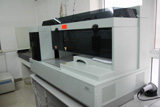Some Reasons Of Nephrotic Syndrome Induce The Pulmonary Embolism
2018-09-27 11:11
 To most kidney patients they often have some discomforts and to most patients with pulmonary embolism may have predisposing factors for the disease, and only 6 % of them can not find the predisposing factors for pulmonary thromboembolism. The risk factors include:
To most kidney patients they often have some discomforts and to most patients with pulmonary embolism may have predisposing factors for the disease, and only 6 % of them can not find the predisposing factors for pulmonary thromboembolism. The risk factors include:
1. Age and gender autopsy data show that the incidence of pulmonary embolism increases with age, with the incidence of children being about 3 % and 20 % for those over 60 years of age. Pulmonary embolism is most common in the 50 – 60 age group, with 90 % of fatal pulmonary embolism occurring over the age of 50. There is no significant difference between sex and the occurrence of pulmonary embolism in children and adolescence. The incidence of DVT in women aged 20 – 39 years is 10 times higher than that in men of the same age.
2. Thrombus phlebitis and varicose veins are estimated to affect about 2 million people in the United States every year, including about 10 % with pulmonary embolism. 72 % of patients with acute spinal injury and 34 % of patients with acute myocardial infarction can develop deep venous thrombosis.The latter had deep venous thrombosis in 71 % of patients over the age of 70. The increase of deep venous diseases of lower limbs after acute myocardial infarction is related to hypercoagulability, shock, heart failure and bed rest ( more than 5 days ).
Pulmonary arteriography and radionuclide lung perfusion scan showed that 51 % ~ 71 % of patients with deep venous thrombosis of lower limbs may have pulmonary embolism. The most common sites of venous thrombosis are venous valve and venous sinus, especially deep veins, such as peroneal vein, popliteal vein, iliac vein, femoral vein, pelvic venous plexus, etc. The reason why venous thrombosis falls off is not clear. It may be related to a sharp rise in venous internal pressure or a sudden increase in venous blood flow ( such as forced defecation, sudden movement after long-term bed rest, etc. ).
Including Ⅸ, Ⅸ factor decreased, V, Ⅷ, X factor, fibrinogen, β – thromboglobulin and platelet increased. The adhesion and agglutination of platelets were enhanced. Antithrombin Ⅲ and fibrinolytic enzyme activity decreased. Therefore, the cause of hypercoagulability in nephrotic syndrome is the increase of procoagulant and procoagulant factors, the decrease of anticoagulative and anticoagulant factors and the damage of fibrinolytic mechanism. The use of antibiotics, hormones and diuretics is an aggravating factor for venous thrombosis. Hormones act through clotting proteins, while diuretics concentrate blood and increase blood viscosity.
From the comments about the pulmonary embolism you can know more knowledge,and if you have similar symptoms and want to find the reasonable treatment please contact us through the following:
E-mail: kidneyservice@hotmail.com
WhatsApp: +8615512139310
Any kidney problems? Please consult our online doctor. The satisfaction of patient is as high as 93%.
What you also want to know:
How can I get this treatment ?
How can I get this treatment in my counties ?
How much is this treatment ?
What is the duration if I receive this treatment in your hospital ?
How can I go to your hospital ?
Tag: Predisposing factors Age and gender autopsy data Thrombus Phlebitis Pulmonary arteriography Pulmonary embolism
Pre: Hypercoagulable State Is The Obvious Symptom Of Patients With Nephrotic Syndrome
Next: None
Leave a Message
Any questions?Fill the form below and we will surely attend to you within 24 hours.Free medical answers from experts!
About Hospital
Patient Story
- The Key Point In The Course Of Treatment
- Drinking More And Urinate Frequently Means Kidney Problems
- How To Deal With Occult Blood With Correct Methods.
















